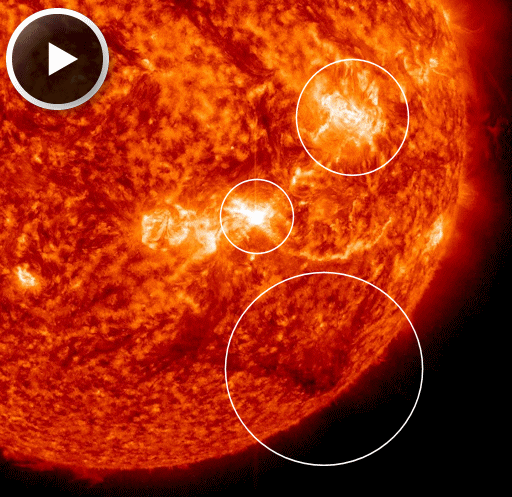From Space.com
The sun erupted with two of the strongest solar flares it can unleash Friday (Oct. 25), just days after blasting an intense solar storm at Earth.
The sun fired off a flare that registered at X1.7 on the space weather scale at 4:01 a.m. EDT (0801 GMT) Friday, then followed with an X.2-class event at 11:03 a.m. EDT (1503 GMT). NASA's Solar Dynamics Observatory captured video of the X1.7 solar flare, which came after several smaller sun storms over the last few days.
Both powerful flares erupted from a new sunspot cluster called Region 1882 and sparked temporary radio blackouts, officials with the National Oceanic and Atmospheric Administration's Space Weather Prediction Center (SWPC) said in an update. But neither eruption is likely to spark major geomagnetic storms in Earth's magnetic field, they added. [Solar Max: Sun Storm Photos of 2013]
Astronomers classify solar flares into three categories — C, M and X — with C being the weakest and X the strongest. When aimed directly at Earth, X-class sun eruptions can interfere with satellite-based communications and navigation systems and also endanger astronauts in orbit.
Update from SpaceWeather on these solar flares Oct. 26, 2013:
WEEKEND FORECAST: Solar activity remains high. NOAA forecasters estimate a 70% chance of M-flares and a 35% chance of X-flares during the next 24 hours. Over the next three days (Oct. 26-28), a series of CMEs created by the recent limb eruptions will deliver glancing blows to Earth's magnetic field, possibly sparking polar geomagnetic storms. Aurora alerts: text, voice.
INTERCONNECTED SOLAR ACTIVITY: The X1-flare of Oct. 25th was remarkable not only for its strength, but also for its interconnectedness. The flare was bracketed by two erupting magnetic filaments, each located hundreds of thousands of kilometers from the instigating sunspot AR1882. The whole episode, shown in this SDO movie, was reminiscent of the famous global eruption of August 2010.
Today, Oct. 26th, it happened again. Click this LINK, of the sun's southwestern quadrant and watch a sequence of flare activity around sunspots AR1875 and AR1877 followed by a filament eruption off the SW limb:

Instead of being a sequence of unrelated events, these flares and eruptions are likely connected by magnetic fields, which thread through the whole broad region. Like dominoes falling, one explosion triggers another as shock waves follow magnetic fields from blast site to blast site.
